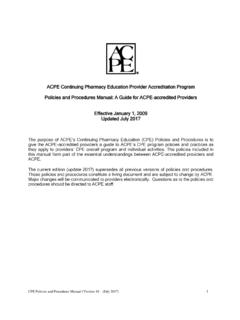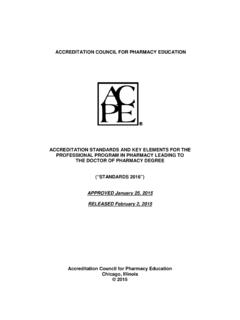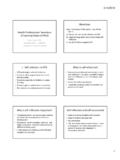Transcription of Accreditation Council for Pharmacy Education Released ...
1 Accreditation Council for Pharmacy Education Accreditation Standards for Continuing Pharmacy Education Adoption: June 20, 2007 Released : October 5, 2007 Effective: January 1, 2009 Version 2: Released March 2014 Version 3: Released July 2017 Accreditation Council for Pharmacy Education Chicago, Illinois 2007 Accreditation Standards for Continuing Pharmacy Education Version 3: Released July 2017 2 Contents Preamble Accreditation Council for Pharmacy Education Overview Standards for Continuing Pharmacy Education Section I: Content of Continuing Pharmacy Education Activities Standard 1: Achievement of Mission and Goals of the CPE Program Standard 2: Gap Analysis Standard 3: Continuing Pharmacy Education Activities Standard 4: CPE Activity Objectives Standard 5: Standards for Commercial Support Section 2: Delivery of CPE Activities Standard 6: Faculty Standard 7: Teaching and Learning Methods Standard 8: Educational Materials Section 3: Assessment Standard 9: Assessment of Learning Standard 10: Assessment Feedback Section 4: Evaluation Standard 11: Evaluation of CPE Activities Appendices Appendix I.
2 Accreditation Council for Pharmacy Education Definition of Continuing Education for the Profession of Pharmacy Glossary Accreditation Standards for Continuing Pharmacy Education Version 3: Released July 2017 3 Accreditation Council for Pharmacy Education (ACPE) Overview The Accreditation Council for Pharmacy Education (ACPE) is the national agency for the Accreditation of professional degree programs in Pharmacy and providers of continuing Pharmacy Education . ACPE (until 2003 known as the American Council on Pharmaceutical Education ) was established in 1932 for the Accreditation of professional degree programs in Pharmacy , and in 1975 its scope was broadened to include Accreditation of providers of continuing Pharmacy Education ( ).
3 ACPE expanded its activities to include evaluation and certification of professional degree programs internationally in 2011 and entered into a collaboration with the American Society of Health-System Pharmacists (ASHP) to accredit Pharmacy technician Education and training programs beginning in 2014. The mission of ACPE is to assure and advance quality in Pharmacy Education . ACPE is an autonomous and independent agency whose Board of Directors is appointed by the American Association of Colleges of Pharmacy (AACP), the American Pharmacists Association (APhA), the National Association of Boards of Pharmacy (NABP) (three appointments each), and the American Council on Education (ACE) (one appointment).
4 State boards of Pharmacy require that licensure applicants from the United States be graduates of an accredited Pharmacy degree program to be eligible to sit for the North American Pharmacist Licensure ExaminationTM (NAPLEX ). In addition, all state boards of Pharmacy require pharmacists to participate in accredited or otherwise approved continuing Education activities for relicensure. A growing number of state boards of Pharmacy require Pharmacy technicians to participate in continuing Education for re-registration or relicensure. These Standards were created in order to meet those requirements. Accreditation Standards for Continuing Pharmacy Education Version 3: Released July 2017 4 Standards for Continuing Pharmacy Education Section I: Content of Continuing Pharmacy Education (CPE) Activities The purpose of the standards in this section is to ensure that the provider s continuing Pharmacy Education program has a clearly articulated mission, desired goals and a planning process to achieve the mission and goals.
5 The mission, goals, and activities must be related to the vision and educational needs of the profession of Pharmacy to better serve society. As recommended by the Health and Medicine Division (HMD) a division of the National Academies of Sciences, Engineering, and Medicine (the National Academies), formerly named the Institute of Medicine, for all health care professionals, pharmacists and Pharmacy technicians must be educated to deliver patient-centered care as members of an interprofessional team, emphasizing evidence-based practice, quality improvement approaches, and informatics. Standard 1: Achievement of Mission and Goals of the CPE Program Standard 2: Gap Analysis Standard 3: Continuing Pharmacy Education Activities Standard 4: CPE Activity Objectives Standard 5: Standards for Commercial Support Accreditation Standards for Continuing Pharmacy Education Version 3: Released July 2017 5 Standard 1: Achievement of Mission and Goals of the CPE Program The provider must develop a CPE mission statement that defines the basis and intended outcomes for the majority of educational activities the provider offers.
6 Providers must establish and implement evaluation plans that assess achievement and impact of stated mission and goals. They must use this information for continuous development and improvement of the CPE program. Guidance: Part I: Mission and Goals Providers should develop a mission related to its CPE Program. The CPE mission statement should indicate the provider s short-term intent in conducting CPE activities, including the intended audience and the scope of activities. The CPE mission should address how a provider will assist pharmacists and/or Pharmacy technicians to maintain and enhance their professional competencies to practice in various settings. Examples may include, but are not limited to: ensuring optimal medication therapy outcomes and patient safety, managing practice settings, satisfying the educational requirements for pharmacist relicensure, meeting recertification requirements for Pharmacy technicians, and/or meeting certification, statewide protocols, collaborative practice agreements.
7 Providers should develop a strategic plan and/or goals to indicate how the mission will be achieved. CPE goals are concise and measurable statements of what the provider intends to do to achieve its CPE Mission. The mission and goals should be systematically evaluated and periodically updated to assure consistency among the mission, overall goals, and individual activities. Part II: Assessment Plan The provider should develop an evaluation plan, that includes measurement indicators or benchmarks, to document achievement of the provider s CPE mission and goals in an effort to maintain and enhance competence of pharmacists and Pharmacy technicians. For example, data may be collected in aggregate across CE activities to show the impact of the provider s CPE program.
8 The impact of the provider s CPE program can be measured using the following levels (adapted from Moore s levels): Participation: number of participants attending CPE activities Satisfaction: directly measuring satisfaction with learning activities, topic, level of content, and speaker's organization of the material Learning: pre- and post-tests, self-assessment tools, multiple choice, short answer, essays, presentations Performance: demonstration of skills, application of treatment guidelines Patient Health: compliance rates, reduced physician visits Population Health: morbidity/mortality, infection rates, readmission rates OR the provider may choose to evaluate the impact of its mission depending on the activity type as follows: Accreditation Standards for Continuing Pharmacy Education Version 3: Released July 2017 6 Knowledge-based CPE activity: The levels that may be evaluated are participation, satisfaction, and learning.
9 Application-based CPE activity. The levels that may be evaluated are participation, satisfaction, learning, and performance (demonstration during the activity and intended application in practice). Practice-based CPE activity. The levels that may be evaluated are participation, satisfaction, learning, performance (demonstration during the activity and application in practice post-activity), and, if applicable, patient and/or population health. Part III: Achievement of Mission The provider should demonstrate evidence to indicate the degree to which the mission and goal(s) of the CPE program are met. Based on the results of the evaluation plan, the provider s mission and goals should be evaluated and updated in order to continue to enhance one s CPE program.
10 Standard 2: Gap Analysis The provider must develop CPE activities based on a knowledge, skill, or practice gap. The provider should identify gaps between what pharmacists and Pharmacy technicians currently know or do and what is needed and desired in practice. Guidance: An identified knowledge, skill, and/or practice gap should guide content development and delivery of CPE activities. These may include legislation change, evaluation from a regulatory or accrediting body ( Joint Commission), release of new or updated evidence-based treatment guidelines, self-report from practitioners, etc. Providers should identify the root of the identified gap ( the specific knowledge, skill, attitude, experience) which should inform the activity type, learning objectives, active learning exercises, and outcomes.




